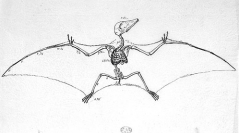

 Comptes Rendus Palevol
3 (2) - Pages 157-175
Comptes Rendus Palevol
3 (2) - Pages 157-175The oldest known restoration of a pterosaur, sent by Professor Jean Hermann of Strasbourg to Georges Cuvier in Paris in 1800, was never published. But it has been found, along with many of Cuvier’s important papers and letters, in the archives of the central library of the National Museum of Natural History in Paris. The sketch is unusual in many respects because Hermann interpreted the animal as a better possible intermediate between birds and quadrupeds than bats would be. Although Hermann’s reconstruction had little influence on Cuvier, it drew the latter’s attention to Collini’s 1784 paper, the first ever on these animals, which Cuvier would later name ptéro-dactyles without ever seeing the original specimens. Collini’s drawing immediately convinced Cuvier that the mysterious animals were reptiles, and that they could fly. Cuvier’s expertise with the patterns of comparative anatomy allowed him to correct many interpretations of other workers, who visualized pterosaurs as mammals, birds, bats, amphibious or marine animals, or as intermediates between different groups. These somewhat tentative, complex concepts of the structures and ‘affinities’ of prehistoric life reflect the fluidity of pre-evolutionary, horizontal ‘arrangements’ in contrast to later evolutionary, vertical classifications based on ideas about phylogeny. But Collini’s paper also immediately provided a strong theoretical underpinning for Cuvier’s prospectus for his great work, Ossemens Fossiles des Quadrupèdes. Shortly after reading Collini’s paper, Cuvier developed the introduction to his 1800 prospectus, incorporating many of Collini’s rhetorical strategies with his own views. These same ideas also became important in Cuvier’s Discours préliminaire to the Ossemens Fossiles , his most renowned philosophical work.
Pterosauria, Pterodactylidae, Upper Jurassic, Germany, history of Paleontology